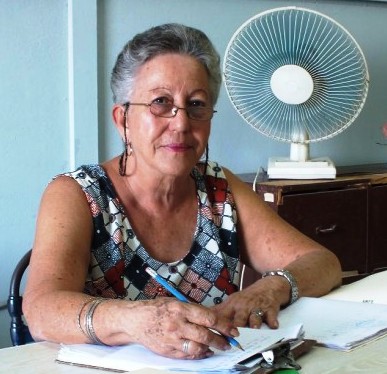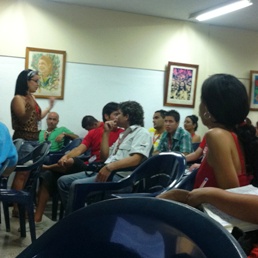Radio Taino emerged from Radio Rebelde, since the studios, technical devices and administrative staff belonged to that station, as well as its executives and assistants.
Its programming was composed of programs from four radio stations and some of its own.
Radio Havana Cuba contributed two hours in English, from three to five p.m., and a half hour in Spanish, which close the daily broadcast with
“Informalmente Informal” by prestigious Cuban journalist Orlando Castellanos (deceased). “Alegrías de Sobremesa” and “Al Son del Danzón”, a music show by Manolo Suarez, were broadcast from Radio Progreso. Radio Enciclopedia contributed a half hour of Cuban instrumentals with its “Interludio Musical.”
On Sundays, produced by Radio Rebelde, it aired “Memorias,” by Manuel Villar – a National Radio Award winner. This was the first show broadcast by Radio Taino with commentaries by renowned Cuban writer and journalist Eduardo Robreño.
Radio Taíno created three programs: “Temprano”, “El Noticiero” and “89 minutos.”
Specific requirements established that the station should use simple, colloquial language, but refined at the same time. Its programming also had other missions and objectives, since spreading Cuban culture and its most genuine roots was of fundamental importance.
In a comprehensive way, Radio Taino’s programming is of profound national nature. It offers the image of our Latin American and Caribbean identity, with special emphasis on the fact that Cuba is an important tourist destination in the region. It’s aimed at foreign visitors arriving to the island as tourists, diplomats, business representatives, technicians and members of companies working in the country. It also took into account, of course, the reception and acceptance of the national audience, mainly tourism workers, and people at workplaces related to services and investments.
In Radio Taino, communication with listeners is carried out by way of a rather colloquial conversation, using a smooth cadence most of the time. By means of these conversations, foreign listeners receive information on the geographical location of places, which include descriptions and detailed information when necessary, which nationals could be aware of.
Although the station maintains that line of work, it began to take its first steps in advertising in 1994. Since then the station adopted a more contemporary programming -artistically valid and commercially viable. Cuban nature and competitiveness continued to coexist in the content and making of its programs.
If at the beginning Radio Taino had notable Cuban radio announcers like Cepero Brito, Oneida Hernandez, Alden Knight, Obelia Blanco, Orlando Castellanos (former executive of the station) German Pinelli, Mireya de la Torre, in its second decade of existence, with the responsibility of guiding international market and foreign investment, programs became more lively. Its presence at trade fairs, cultural events, and the promotion of shows organized by the station in cooperation with some of the most prestigious Cuban musicians, like Chucho Valdes, Juan Formell and many more contributed to this goal, thus creating unique shows of great popularity for tourist and cultural institutions.
Among the means used by Radio Taíno since its early days we find social research, which have made it possible to know the opinions of listeners and how frequently they listen to programs. It was a must for the station to work with this tool because it was necessary to know whether it had broadcast an advertising spot in a wrong way or given an unfavorable image.
This research work also allowed Radio Taíno to know about possible needs and dissatisfactions on the part of listeners concerning content, and make the necessary changes to improve it. Also, creators participate in the line to be followed, and the staff has a sense of belonging, hence the audience’s acknowledgement of the station’s programs and producers.
Ratings have always been over 80%, between good and very good. Nevertheless, the station carries out a daily monitoring of its work, concentrating on its profile and the elements supporting its Cuban nature, which has been acknowledged during research works and visits by the programming management of Cuban Radio.
Among other elements it has worked on we find workshops and theoretical debates on what is done, as well as the updating of communication models applicable to the station.
Although expectations have not totally been met, it can be said that these measures have contributed to the increase in ratings achieved by the station, taking into account that it’s a station in the capital and that it was not present in other Cuban provinces for many years.
Still with challenges ahead Radio Taíno celebrated its 25th anniversary on November 3rd. Some of these challenges are being in tune with the structures of its audiences and keeping in mind cultural ones, since the station is no longer heard in Ciudad de La Habana only, but in almost all of the island’s provincial capitals as well.
Over 80 percent of the music broadcast by Radio Taíno is Cuban music. Today, its main challenge is to comply with the new demands of its audiences with priority and professionalism, trying to represent them by way of themes that can move listeners to reflect and give their opinion, incorporating them creatively in its programming, according to the profile of the radio station.
Translated by Silke Páez




